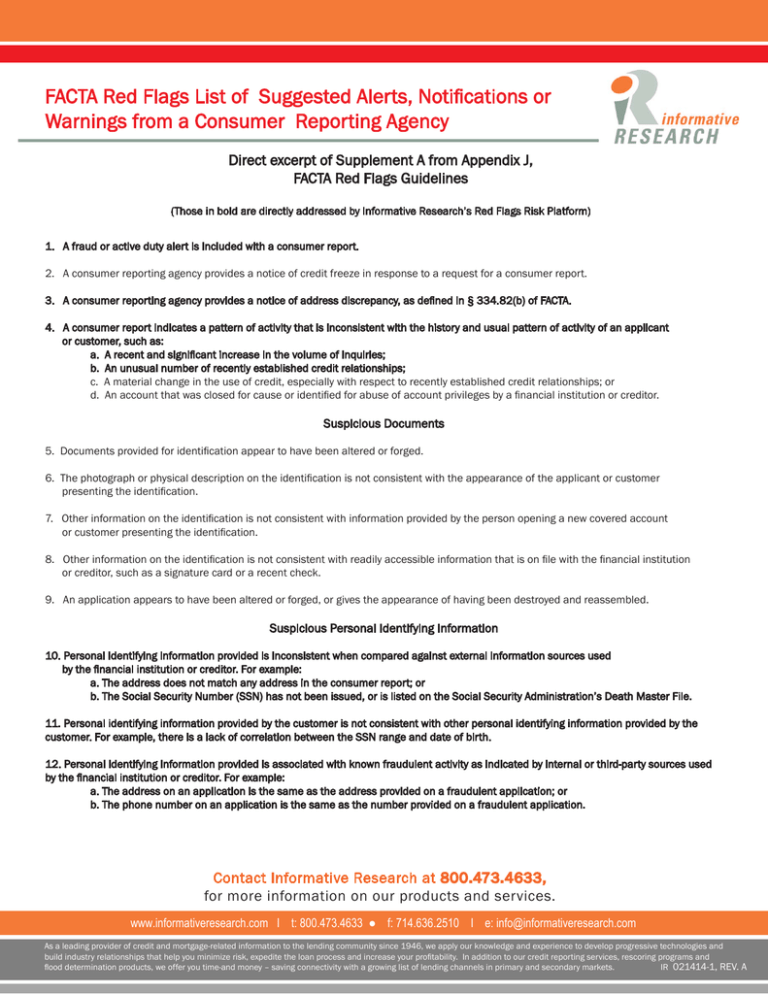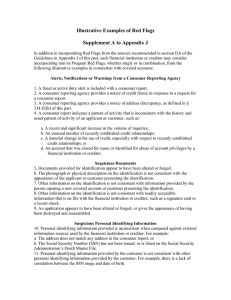FACTA Red Flags List of Suggested Alerts, Notifications or Warnings
advertisement

FACTA Red Flags List of Suggested Alerts, Notifications or Warnings from a Consumer Reporting Agency Direct excerpt of Supplement A from Appendix J, FACTA Red Flags Guidelines (Those in bold are directly addressed by Informative Research’s Red Flags Risk Platform) 1. A fraud or active duty alert is included with a consumer report. 2. A consumer reporting agency provides a notice of credit freeze in response to a request for a consumer report. 3. A consumer reporting agency provides a notice of address discrepancy, as defined in § 334.82(b) of FACTA. 4. A consumer report indicates a pattern of activity that is inconsistent with the history and usual pattern of activity of an applicant or customer, such as: a. A recent and significant increase in the volume of inquiries; b. An unusual number of recently established credit relationships; c. A material change in the use of credit, especially with respect to recently established credit relationships; or d. An account that was closed for cause or identified for abuse of account privileges by a financial institution or creditor. Suspicious Documents 5. Documents provided for identification appear to have been altered or forged. 6. The photograph or physical description on the identification is not consistent with the appearance of the applicant or customer presenting the identification. 7. Other information on the identification is not consistent with information provided by the person opening a new covered account or customer presenting the identification. 8. Other information on the identification is not consistent with readily accessible information that is on file with the financial institution or creditor, such as a signature card or a recent check. 9. An application appears to have been altered or forged, or gives the appearance of having been destroyed and reassembled. Suspicious Personal Identifying Information 10. Personal identifying information provided is inconsistent when compared against external information sources used by the financial institution or creditor. For example: a. The address does not match any address in the consumer report; or b. The Social Security Number (SSN) has not been issued, or is listed on the Social Security Administration’s Death Master File. 11. Personal identifying information provided by the customer is not consistent with other personal identifying information provided by the customer. For example, there is a lack of correlation between the SSN range and date of birth. 12. Personal identifying information provided is associated with known fraudulent activity as indicated by internal or third-party sources used by the financial institution or creditor. For example: a. The address on an application is the same as the address provided on a fraudulent application; or b. The phone number on an application is the same as the number provided on a fraudulent application. Contact Informative Research at 800.473.4633, for more information on our products and services. www.informativeresearch.com I t: 800.473.4633 ● f: 714.636.2510 I e: info@informativeresearch.com As a leading provider of credit and mortgage-related information to the lending community since 1946, we apply our knowledge and experience to develop progressive technologies and build industry relationships that help you minimize risk, expedite the loan process and increase your profitability. In addition to our credit reporting services, rescoring programs and flood determination products, we offer you time-and money – saving connectivity with a growing list of lending channels in primary and secondary markets. IR 021414-1, REV. A FACTA Red Flags List of Suggested Alerts, Notifications or Warnings from a Consumer Reporting Agency 13. Personal identifying information provided is of a type commonly associated with fraudulent activity as indicated by internal or third-party sources used by the financial institution or creditor. For example a. The address on an application is fictitious, a mail drop, or prison; or b. The phone number is invalid, or is associated with a pager or answering service 14. The SSN provided is the same as that submitted by other persons opening an account or other customers. 15. The address or telephone number provided is the same as or similar to the account number or telephone number submitted by an unusually large number of other persons opening accounts or other customers. 16. The person opening the covered account or the customer fails to provide all required personal identifying information on an application or in response to notification that the application is incomplete. 17. Personal identifying information provided is not consistent with personal identifying information that is on file with the financial institution or creditor. 18. For financial institutions and creditors that use challenge questions, the person opening the covered account or the customer cannot provide authenticating information beyond that which generally would be available from a wallet or consumer report. Unusual Use of, or Suspicious Activity Related to, the Covered Account 19. Shortly following the notice of a change of address for a covered account, the institution or creditor receives a request for new, additional, or replacement cards or a cell phone, or for the addition of authorized users on the account. 20. A new revolving credit account is used in a manner commonly associated with known patterns of fraud patterns. For example: a. The majority of available credit is used for cash advances or merchandise that is easily convertible to cash (e.g., electronics equipment or jewelry); or b. The customer fails to make the first payment or makes an initial payment but no subsequent payments. 21. A covered account is used in a manner that is not consistent with established patterns of activity on the account. There is, for example a. Nonpayment when there is no history of late or missed payments; b. A material increase in the use of available credit; c. A material change in purchasing or spending patterns; d. A material change in electronic fund transfer patterns in connection with a deposit account; or e. A material change in telephone call patterns in connection with a cellular phone account. 22. A covered account that has been inactive for a reasonably lengthy period of time is used (taking into consideration the type of account, the expected pattern of usage and other relevant factors). 23. Mail sent to the customer is returned repeatedly as undeliverable although transactions continue to be conducted in connection with the customer’s covered account. 24. The financial institution or creditor is notified that the customer is not receiving paper account statements. 25. The financial institution or creditor is notified of unauthorized charges or transactions in connection with a customer’s covered account. Notice from Customers, Victims of Identity Theft, Law Enforcement Authorities, or Other Persons Regarding Possible Identity Theft in Connection with Covered Accounts Held by the Financial Institution or Creditor 26. The financial institution or creditor is notified by a customer, a victim of identity theft, a law enforcement authority, or any other person that it has opened a fraudulent account for a person engaged in identity theft. Contact Informative Research at 800.473.4633, for more information on our products and services. www.informativeresearch.com I t: 800.473.4633 ● f: 714.636.2510 I e: info@informativeresearch.com As a leading provider of credit and mortgage-related information to the lending community since 1946, we apply our knowledge and experience to develop progressive technologies and build industry relationships that help you minimize risk, expedite the loan process and increase your profitability. In addition to our credit reporting services, rescoring programs and flood determination products, we offer you time-and money – saving connectivity with a growing list of lending channels in primary and secondary markets. IR 021414-1, REV. A

